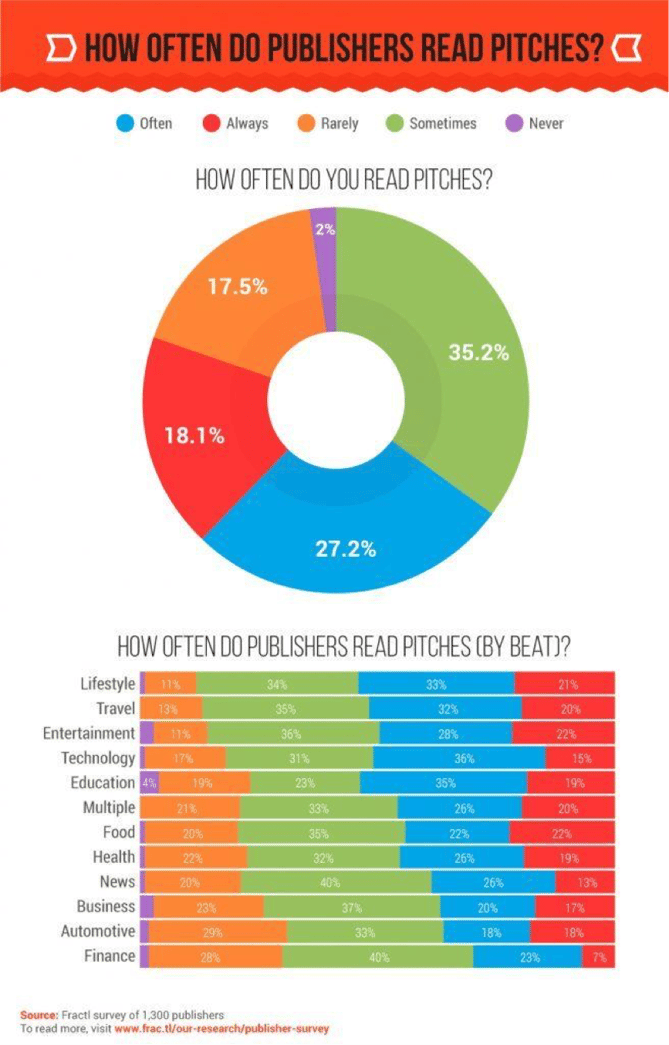
The media needs content to report, and marketers need exposure for their content. Together, it seems like these two would have a pretty simple, mutually beneficial relationship, right?
Unfortunately, like most modern-day relationships, it’s never really that simple. Marketers and PR professionals have long been denounced by the media as spin doctors thanks to poor outreach practices and failing to create valuable content that goes beyond selling a product or service.
Luckily, the industry is evolving past the point of flooding the inboxes of time-starved journalists with irrelevant press releases with the help of more strategic outreach planning. Just as marketing has shifted toward an inbound strategy of attracting a specific audience rather than forcing messages to the masses, PR has assumed a similar mindset by strategically targeting the best-fit publications and influencers to promote content made for a target audience rather than a “spray and pray” mentality. 
Still, pitching isn’t easy, but communication is key for building and nurturing the symbiotic relationship between marketers and the media. That’s why my team at Fractl surveyed over 1,300 writers, editors, and contributors at countless publications to get a better idea of how to guide our own media outreach strategy.
The information proved to be invaluable for our digital PR team, so we wanted to share how the publishers’ insights can help your team improve your brand’s media outreach efforts in a five-step guide.
5 Steps for Improving Your Media Outreach
Define your audience.
Marketers know defining your ideal buyer persona offers helpful insights to guide everything from product development to content creation. In that same vein, gathering information about stakeholders across your brand is immensely helpful in defining your ideal target audience for content distribution.
Further, understanding not only the demographics, challenges, and motivations of your target audience, but also their online (and offline) behavior will help define your ideal audience and ultimately guide your outreach strategy. Specifically, it will help you better understand where they consume their news, turn to for insights and advice, and seek out entertainment.
Build media lists.
Become familiar with the publications and media outlets your ideal audience frequents, then vet the publications before going on to research the best-fit contact. Run through a mental checklist for each publication before adding them to your list build:
- Do they publish third-party content?
- Do they regularly post on the topic you’re planning to pitch?
- Do they frequently promote their posts via other channels like social media?
Once the publication has passed this quick preliminary phase, go on to find the best-fit contact by scanning through their editorial contact list. Further research a few contacts whose beat fits your content and trace their online footprint. Start following them on their professional social accounts and keep an eye out for their recent work or contributions to other online media like podcasts. Commenting on their latest post or podcast appearance, or giving your genuine opinion about a topic you’re both well-versed in, is a great way to start off your pitch.
Obviously their beat must align with the topic of the content you plan to pitch, but make sure you also run through the second mental checklist:
- Do they cite content produced by brands?
- Do their posts see a lot of engagement?
- Do they cover only breaking news or only write personal essays and critics, or do they feature timely and evergreen content?
- Do they demonstrate values that align with your brand?
Researching who to contact can be time consuming, especially when initially starting a media outreach strategy. Fortunately, as time goes on, the investment pays off in the form of established, mutually beneficial relationships.
Grab their attention.
You only have one chance to make a good first impression, and when it comes to pitching, you only have a few seconds to make sure your email stands out in the overflowing inboxes of busy journalists. There are really only two things that can set a pitch apart at first glance: the sender (i.e., your name and email address) and the subject line.
While you can eventually build relationships and gain credibility solely on your name, your subject line is initially the deciding factor when it comes to whether or not your pitch is even opened, let alone read. Considering 57% of publishers receive between 50 and 500 pitches per week, it’s imperative to take your subject line seriously and consider some A/B testing.
After sending hundreds of pitches, I’ve learned treating subject lines like potential article headlines that match the journalist’s style of writing seems to have a higher open rate and the pitch is more likely to get a response -- and our survey results support this observation. My theory is emulating their diction and syntax while also offering a compelling statistic or high-level summary of your content helps them envision a story.
Like news headlines, subject lines can be straightforward, data-driven facts pulled from the content, or can pose a question to pique curiosity about the content’s findings. According to our survey, news organizations opt for stat-heavy subject lines while beats like finance prefer more inquisitive subject lines.
Another option well-suited for more conversational pitches is to personalize the subject line based on the information you find while researching your potential contact. The survey revealed lifestyle and entertainment writers are most likely to open a personalized email compared with other types of subject lines.
It varies by beat, but only 2% of publisher revealed they never read pitches while nearly 45% always or often read them. These numbers indicate the odds of your pitch getting seen are more likely than not, so journalists moving a pitch straight to the spam folder should not be the go-to reasoning for a pitch going unanswered. Instead, consider the contents of the pitch itself.

Develop the story.
The best pitches outline the story relevant to the writer’s unique audience clearly and concisely. Consider potential news headlines and the key message your content is conveying to that specific audience. Communicate the valuable newsworthy elements of the content (more on that below) and call out the most compelling or emotional insights from the content in a quick bullet list. In many cases, the same piece of objective content can offer several different story angles that would interest multiple audience profiles, so be sure to tailor the elements and insights you call out to the writer’s audience.
Since pitches should be 100–200 words max (half of survey respondents preferred this cursory length compared with just 10% preferring over 300 words), data visualizations and other visual media are ideal assets to link in your pitch to further support such a story angle without blocks of text. In fact, when asked what type of supporting assets they wish to see more of, publishers revealed visual content formats like infographics, photos, and videos were highest in demand, while generic press releases and text-heavy white papers fell to the bottom of the list.
Prove your value.
An attention-grabbing subject line, personalized introduction, and uniquely developed story are vital components to an effective pitch, but they won’t mean anything if you fail to prove your content’s value to the writer and their audience.
The media strives to report and share original, newsworthy content from credible sources, so be sure you highlight how your content aligns with their priorities by explaining how it exemplifies these three qualities of valuable content:
- Credible: Journalism ethics stress citing content whose data is credible and authoritative, so be sure to include the data source or methodology in which your content is based on.
- Newsworthy: Highlight newsworthy elements of the content like its timeliness to a trending topic or proximity to a local readership.
- Relevant: As mentioned above, point out how your content relates and will resonate to the publication’s audience. Will it educate, entertain, or inspire their readers?
While it may seem time consuming to thoroughly research every single reporter you email, write a personal connection to kick off every single pitch, or tailor a value proposition to each audience, it’s time well spent to make your pitch stand out.
from HubSpot Marketing Blog https://blog.hubspot.com/marketing/improving-media-outreach-publisher-survey

No comments:
Post a Comment